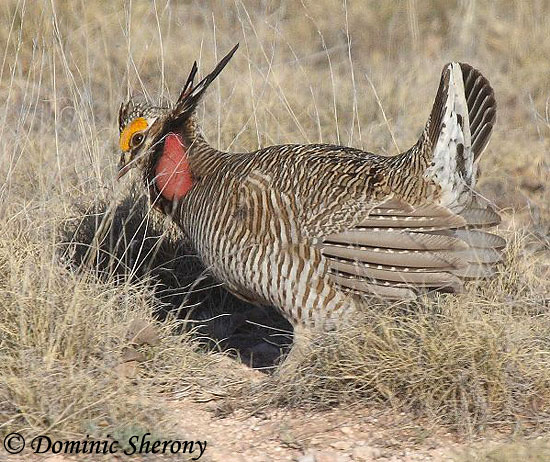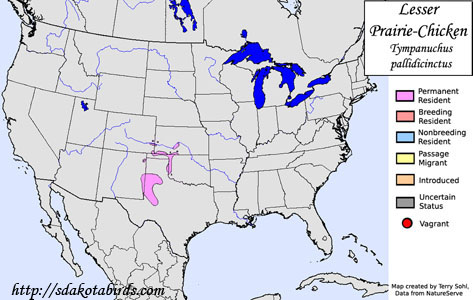| Length: 16 inches | Wingspan: 25 inches | Seasonality: Non-resident in South Dakota |
| ID Keys: Generally distinctive in range. Grayish-brown overall, barring on back and underparts. | ||
 The
Lesser Prairie-Chicken is a very close relative of the
Greater Prairie-Chicken, but
the ranges of the two species do not overlap. Numbers of the species
have declined precipitously since the late 1800s, and they are now found in
only a fraction of their former habitat, in scattered locations in Texas,
New Mexico, Kansas, and Oklahoma. The species had declined
already by the 1930s, with hunting restrictions in place in some regions
even then. However, continued habitat losses have continued to result
in a decline and fragmentation of remaining birds.
The
Lesser Prairie-Chicken is a very close relative of the
Greater Prairie-Chicken, but
the ranges of the two species do not overlap. Numbers of the species
have declined precipitously since the late 1800s, and they are now found in
only a fraction of their former habitat, in scattered locations in Texas,
New Mexico, Kansas, and Oklahoma. The species had declined
already by the 1930s, with hunting restrictions in place in some regions
even then. However, continued habitat losses have continued to result
in a decline and fragmentation of remaining birds.
Habitat: Prefers shortgrass prairie with scattered shrubs, especially seeming to favor shrubby oaks referred to as "shin oaks". They will use agricultural land to feed on seeds and grains, but without adequate, large expanses of grassland in proximity to agricultural land, the species does poorly. Historically, the species often was found in and around prairie dog towns, but prairie dog town area in the western U.S. has declined by over 98% since the mid-1800s. Leks, the breeding grounds of Lesser Prairie-Chickens, used to often be found on prairie dog towns.
Diet: Feeds on a variety of plant and animal matter, including seeds, berries, leaves, buds, acorns, waste grain, and insects.
Nesting: Breeding occurs on leks, breeding grounds where males display to females. Leks are often used year after year, although lek locations may change if habitat change has occurred. After mating, the females move to nesting habitat, typically within a mile or two of the breeding lek. When the young hatch, females tend to the young on brooding grounds that are typically more open in nature than the nesting grounds, with a higher proportion of grasses and forbs and fewer shrubs.
Song: Display of the male is accompanied by a low series of hooting and clucking. Clucking notes can also be heard from both species.
Migration: A permanent resident throughout its range.
Interactive eBird Map: Click here to access an interactive eBird map of Lesser Prairie Chicken sightings
Similar Species: Greater Prairie-Chicken is very similar, but the range of the two species do not overlap.
Conservation Status: The IUCN "red-list" shows the species as "vulnerable". Populations have declined drastically since the 1800s, and the range of the species is now scattered and localized. The species is not yet listed as threatened or endangered in the U.S., but in 1995, U.S. Fish and Wildlife deemed such a listing was "warranted", and designation as a threatened species is possible in the very near future. Despite the population declines, hunting is still allowed in some states in its range.
Further Information: 1) Cornell's All About Birds - Lesser Prairie-Chicken
2) U.S. Fish and Wildlife - Lesser Prairie-Chicken
3) Wild Earth Guardians - Lesser Prairie-Chicken
Photo Information: April 11th, 2008 - West Texas - Dominic Sherony - Photo licensed uncer Creative Commons Attribution Share-Alike 2.0 Generic License.
| Click below for a higher-resolution map |
 |
| South Dakota Status: Non-resident in South Dakota |
Additional Lesser Prairie-Chicken Photos (coming soon!!)
